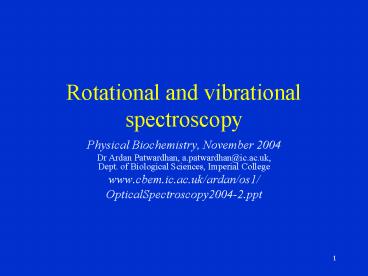Rotational and vibrational spectroscopy - PowerPoint PPT Presentation
1 / 15
Title:
Rotational and vibrational spectroscopy
Description:
... vibrations (10-13s), which in turn is several orders of magnitude longer than ... Any molecular vibration can be described as a linear combination of the ... – PowerPoint PPT presentation
Number of Views:802
Avg rating:3.0/5.0
Title: Rotational and vibrational spectroscopy
1
Rotational and vibrational spectroscopy
- Physical Biochemistry, November 2004
- Dr Ardan Patwardhan, a.patwardhan_at_ic.ac.uk,Dept.
of Biological Sciences, Imperial College - www.cbem.ic.ac.uk/ardan/os1/
- OpticalSpectroscopy2004-2.ppt
2
Born-Oppenheimer approximation
- The time-scale for rotations(10-11s) is several
orders of magnitude longer than the time-scale
for vibrations (10-13s), which in turn is several
orders of magnitude longer than electronic
transitions(10-15s) - The influence of each of these phenomena can
therefore be viewed separately, and the energy
levels are simply the sum of the energy
contributions from the three phenomena
3
Born-Oppenheimer approximation
Total
4
Molecular rotation
- Can be probed with microwave radiation in the
case of molecules with electric dipole moments,
e.g. heteronuclear diatomic molecules - Can be used to determine bond lengths in small
molecules
5
Vibrating diatomic molecule Simple harmonic
oscillator
6
Simple harmonic oscillator
- Note that E0 ? 0 ? molecule is always vibrating
and never completely still ! Manifestation of
Heisenberg uncertainty principle
7
The anharmonic oscillator
- In reality, stretching and compressing a bond are
not energetically equivalent - The spacing between energy levels decreases with
increasing u
8
Normal modes
- Normal modes have energy levels that are
independent of each other and can interact with
EMR independently - Any molecular vibration can be described as a
linear combination of the normal modes
9
Polyatomic molecules
- A varying electric dipole is necessary for a
normal mode of vibration to produce a spectra - The symmetric stretch in the above example will
not produce a vibrational spectra
10
Functional groups
- Groups with light atoms have a higher frequency
than groups with heavier atoms - Stretching modes usually have higher frequencies
that bending modes - The stronger the bond the higher the frequency
(triple bond gt double bond gt single bond)
11
Polarizability in an electric field
12
Polarizability in an electric field
- An electric field can distort the electron cloud
of a molecule, thereby creating an induced
electric dipole moment - The oscillating electric field associated with EM
radiation will therefore create an oscillating
induced electric dipole moment which in turn will
emit, i.e. scatter, EM radiation
13
Raman scattering
Molecule
Scattered photon hnsc
Excitation photon hnex
- Rayleigh scattering elastic interaction, no
non-kinetic transfer of energy between molecule
and photon, nsc ? nex - Raman scattering inelastic interaction, transfer
of energy between molecule and photon, nsc ? nex - Stokes lines Energy of molecule increases, nsc lt
nex - Anti-stokes lines Energy of photon increases,
nsc gt nex
14
Raman spectra
- Transitions between vibrational/rotational levels
will lead to spectral lines on either side of the
excitation line - The spectra on the stokes side will be more
intense than the spectra on the anti-stokes side
due to a significant difference in population
between vibrational levels - The difference in energy between these lines and
the central excitation line corresponds to
energies for pure transitions
15
Raman versus IR
- Aqueous solutions can be used
- Any wavelength can be used
- Variation in polarization is a requirement rather
than variation in dipole moment ? some normal
modes that do not show up in IR spectra may show
up in Raman - Good examples are homonuclear diatomic molecules,
e.g. oxygen !! - Some normal modes are invisible to both IR and
Raman spectroscopy!!!































